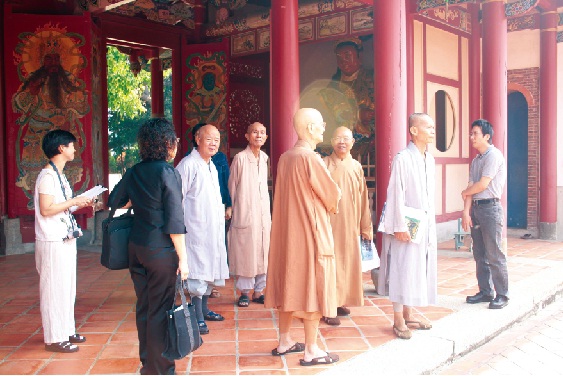METAMORPHOSIS AND RENAISSANCE
Rediscovered Treasure of Kai Yuan Temple
|
ˉˉˉˉˉˉˉˉˉˉˉˉˉBy Abbot Shih Chuan Dao, ˉˉˉˉˉˉˉˉˉˉˉˉˉMiao Sin Temple, ˉˉˉˉˉˉˉˉˉˉˉˉˉMarch 4, 2007 |

|
ˉˉKai Yuan temple is one of the oldest temples in Taiwan. With its long history, lush gardens, grand architecture and solemn serenity, it is one of the most culturally significant temples in Taiwan. However, its historical artifacts have not been systematically managed for 300 years, and many historical documents have consequently gone astray. This is a highly regretable, and hasresulted in the temple's role in Taiwanese history being largely overlooked.
ˉˉI have been researching Kai Yuan Temple's history and collecting ancient documents and the calligraphies written by monks of temple. Having studied a collection of manuscripts from 1930 briefly documenting the history of the temple, and an authentic calligraphy by its second abbot, I feel ashamed that so many important artifacts have been loss from this renowned temple, and I feel duty-bound to begin work on managing the cultural properties of the temple.
ˉˉFrom 1991 to 2001, I taugh at the zen academy of Kai Yuan Temple and proposed the project to the operating team: to fully investigate the collections and documents of the temple along with the records of previous abbots, and catalog them. The next step would be to compile a detailed historical record of the temple. However, it was not until 2006 when I meet with the new abbot of the Temple that my proposal could be accepted. I recommended Miss Wang Lifen as the project manager. An executive team of 11 members was set up on August 18,2006.
ˉˉThis team is experienced in cultural research and each member is a specialist in a field related to this project. In the process of investigation of the temple's artifacts, there were many surprising discoveries. One of the most significant discoveries was the long-sought answer to the mystery of why most records relating to the 27 abbots, from the 8th to the 34th, had disappeared from the temple.
ˉˉIt is most significant that Kai Yuan Temple was originally a royal villa, which was later transformed into a Buddhist temple. Now that the results of this project are being published, I envision the next step as being the creation of a cultural gallery and museum. It is hoped that this cultural project will become part of a consistent effort to contribute to the spiritual and material prosperity of the society.
ˉˉI would like to thank all the members of the team on behalf of Kai Yuan Temple. I hope this project will bring more attention on our cultural legacy, and look forward to the initiation of other innovative cultural projects.